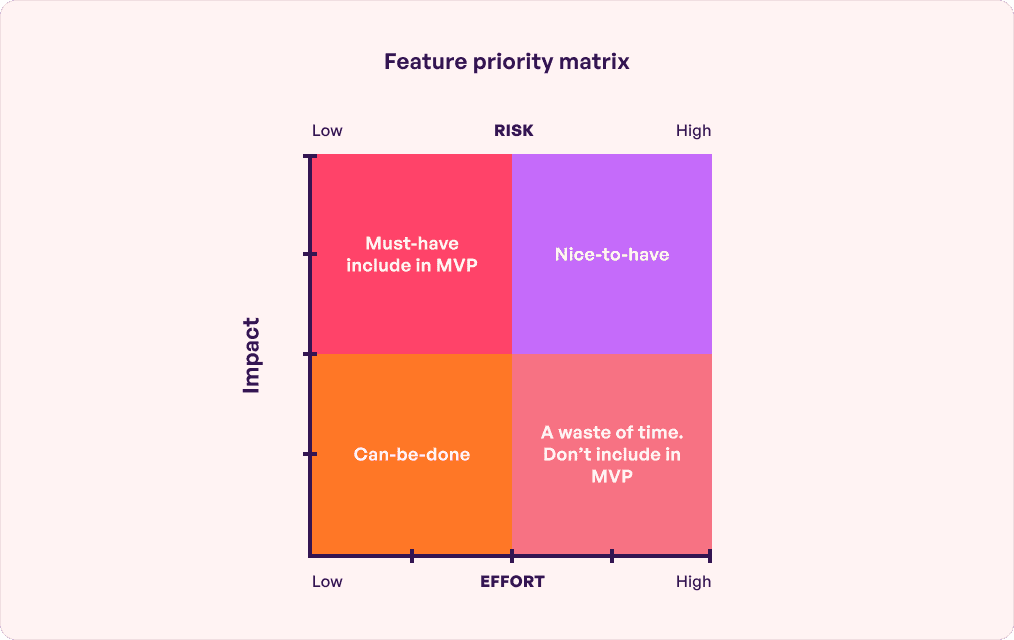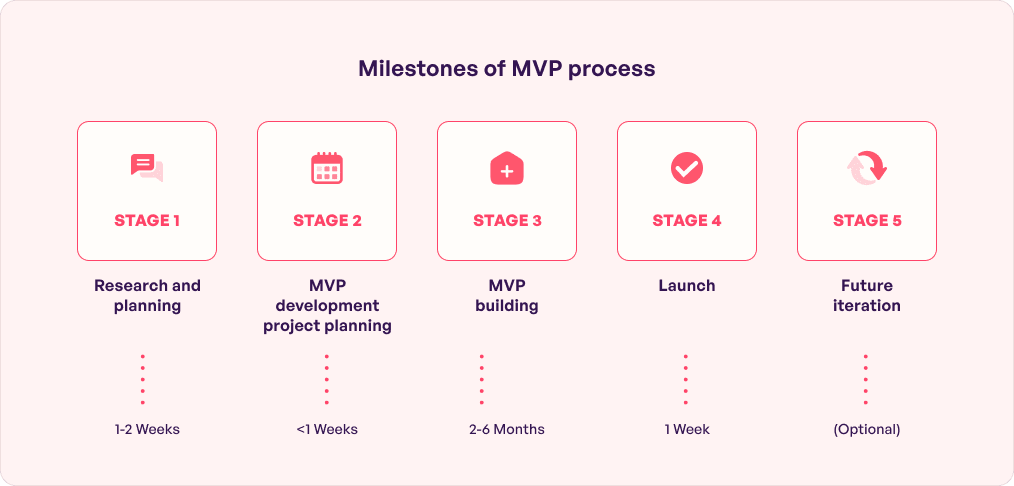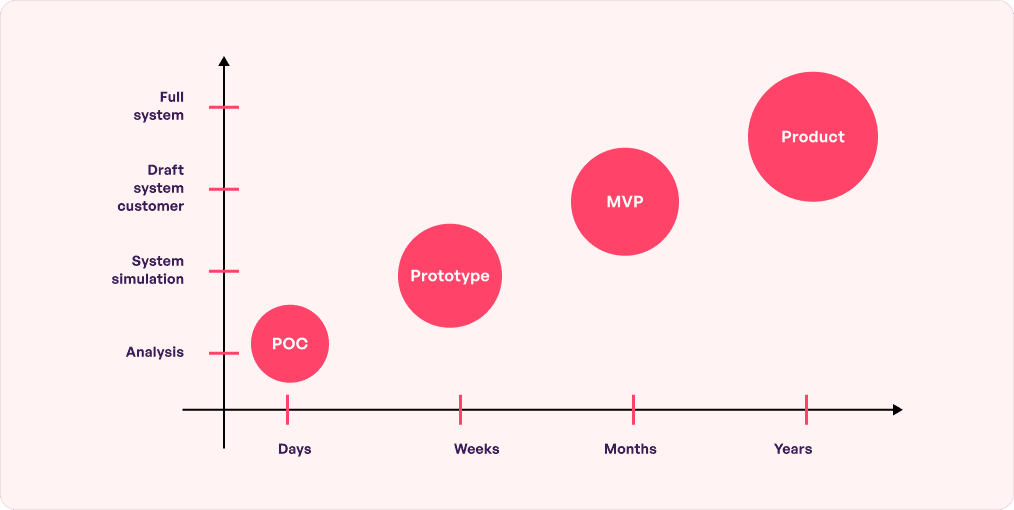Across the globe, early-age startups – particularly ones that are only a few months old – work on some major yet similar limitations: limited manpower, finances, and clarity regarding what would click in the market. For new entrepreneurs who are ambitious about their digital idea, these limitations often come as roadblocks which a number of them turn back from.
Posing as a solution to this scarcity issue, MVP or minimum viable product has come into existence. While everybody who is interested in the digital space might already know what MVP in software development stands for, there is a need to dive into the concept for first-time entrepreneurs.
But before we dive into the technicalities of MVP in development, let us have a brief look at the benefits of MVP in software development.
Table of contents
Role of MVP in software development
In addition to the obvious benefits such as quick go-to-market time and cost efficiency, MVP software development has some less-known advantages and roles to play as well. They include:
- User Feedback Incorporation: MVP comes with the scope for collecting early user feedback, helping the software developers modify and better the product on the basis of real user experiences.
- Risk Mitigation: By making a scaled-down version of the product at an initial level, you can find potential risks and issues at an early stage, lowering the chances of major setbacks happening later in the development journey.
- Resource Optimization: It aids in optimizing resource allocation by concentrating on essential features, thus safeguarding unnecessary investment in non-crucial components.
- Market Validation: MVP serves as an approach for testing the product viability in the market, ensuring that you invest resources in a product that meets user requirements.
- Early Revenue Generation: If the minimum viable product design meets the user expectations and requirements, it can help generate early-stage revenue, which can be reinvested in advanced-grade product development.
- Iterative Development: MVP promotes an iterative development methodology, enabling continuous improvement and adaptation on the basis of user feedback and changing market situations.
While extremely impactful, these pros of MVP in development only help entrepreneurs when they are able to translate them into digital products. Knowing how can make all the difference to the growth trajectory of an application.
While the MVP development for startups process is fairly straightforward, at this point, we believe you must be struggling with a critical question: How to know which features to add to the MVP? After all, this decision will clearly impact the acceptance and future of your product in the market.
Here’s what we tell our clients when they come to us with little idea of MVP version planning.
How to choose MVP features for your application?
As a part of our digital product strategy service offering, we help startups in their MVP development journey from scratch – checking the market viability of their idea, deep-level user, market, and competitors’ research, and even the list of features that would ensure they get maximum feedback and acceptance from Day 0.
This is what we suggest.
After a detailed analysis of your target audience, the biggest issue they are facing and how they are solving it right now, and your competitors’ offerings you will end up with a list of features that would make your application the go-to solution for your customers.
The next part that comes is how to prioritize those features.

The method we use to help define the features is the MoSCow matrix.
It is a prioritization method that consists of dividing all the MVP features into four categories: must have, should have, could have, and won’t have.
- The ‘must-have’ group is of all the mandatory features.
- The ‘should-have’ group comprises functionalities that are not vital but are still significant.
- The ‘could-have’ group includes all the nice-to-have functionalities.
- The ‘won’t have’ group comprises functions that are not of priority at this point but could be added later.
Using the same matrix, you will be able to finalize the features which will then go into mvp software development. With this addressed, let us look into the MVP development process section next to give you the information you would need to build the version.
Step-by-step of the MVP development process
Building the MVP version of a software comes laced with multiple decisions and processes. The idea behind creating an MVP is to release a version that would help gauge real users’ acceptance. Now in order to make it happen, it is important to maintain a competitive edge so that your app version reaches your customers before the competitors’ and this is where tight timelines and clear stages’ definitions come into the picture.
Here’s a breakdown of the stages (and their timelines) that would help translate the efforts into the foundations of a profitable, valuable product.

Research and planning
The first stage of developing a minimum viable product starts with one to two weeks of dedicated product discovery. Here the development team works with you to gather a deep-level understanding of your product, the vision you are looking to achieve, competitor and market analysis, and the general user trends of your app category.
MVP development planning
Typically lasting for less than a week, the stage deals with setting a concrete plan for minimum viable product design, development, and launch. Here, the technicalities of the development journey are fixed ranging from feature selection and design systems to user flow and next-gen tech integrations.
MVP development
At this stage, all the discussions and planning are executed. The designers, developers, and QA team work in an agile mode to develop and release product builds. The build release is usually kept in line with the milestone plan fixed in the previous step.
Creating a version that will be accepted by the users, enough to give feedback, will call for a dedicated effort of over two to six weeks.
MVP version launch
Once the MVP software design and development process is complete and all the critical stakeholders have given their go-ahead on the version, preparation for launch starts. Here, the platforms on which the users are active are considered for priority delivery following which extensive marketing and promotion is done for getting maximum attention to the application.
As an entrepreneur who has chosen to take the MVP route because of its time and cost-efficiency, we are sure it would be critical for you to know how much would it cost to build an MVP. The details that would give you a complete picture of the time and cost of development, however, are too huge to compress in this discussion. So here is a brief look to give you a good enough idea of what to expect cost-wise.
How much can MVP development cost?
The cost of building an MVP can be anywhere between $15k to $200k. The reason behind this wide range gap is led by a number of factors –
- Number and complexity of features
- Applied design system
- Platforms choice for MVP launch
- Technology addition, if any
- Location and team size of the MVP development services providers.
To know which end of the range spectrum your MVP development journey will belong to, get in touch with our business development team today.
As we conclude the article, let us answer another common confusion that entrepreneurs have when starting their digital journey – choosing between different (same intent) models. Oftentimes, businesses are confused between three options – all working with the same intent of finding viability and acceptance of their product – PoC, Prototype, and MVP.
Here are the key differences between them.

Purpose and scope:
Prototype: Used for visualizing and testing the design concepts, interactions, and user experience.
MVP: Developed for finding product-market fit and refining the idea in a real-world setup.
PoC: Built to showcase the feasibility and potential of a product.
Level of functionality:
Prototype: Limited functionality which allows testing the product’s usability.
MVP: Full functionality of features that avoids scope creep.
PoC: No functionality is needed as the main goal is to showcase the core concept.
Audience and timing:
Prototype: Targets internal teams, stakeholders, and potential users in the early development stages.
MVP: Aimed at early adopters, potential customers, and investors to validate the product-market fit.
PoC: Intended for stakeholders, investors, and potential partners to showcase the viability and potential of the idea.
Assuming that your requirements align with what MVP stands for, we suggest not spending too much time to get on the design and development stage. Keeping this article as the base, we hope that you have gathered all the information you need to get started with investing in MVP development services in New Delhi or any other location across the globe.
FAQ
Q. What is MVP development?
A. MVP development for startups is a concept where a critical-level features product is launched in the market to study users’ feedback and acceptance rate. The idea here is to do a quick launch with a minimal set of functionalities that demonstrate the value of your application in the best manner.
Q. How long should MVP development take?
A. Minimum Viable Product design and development can take anywhere between two to six months, or even longer depending on the complexity of the features, platform choice, tech additions, etc.
Q. How much does it cost to develop an MVP?
A. Like time, there is no concrete answer to how much MVP development costs. This too can be anywhere between $15k to $200k depending on elements like the complexity of the features, design system, platform choice, tech additions, etc.
Q. What is the main goal of developing the MVP?
A. The main purpose of building an MVP is to measure the market acceptance of a digital product before its full-fledged version is launched with a lot of money and effort at stake.
Q. What comes after developing an MVP?
A. After the MVP is built, the deployment process starts with priority being given to the platforms and operating systems the majority of users are active on. Post this, dedicated efforts are placed behind promoting the application in order to get maximum user attention.
Q. What is the difference between MVP and MMP?
A. Minimum Viable Product (MVP) helps businesses validate their ideas so it is a very basic version in terms of UX and functionality. The Minimum Marketable Product (MMP), on the other hand, is a version that is ready to be sold, thus it is developed better and offers a good overall user experience.

